With thanks to Peter Corbally of P&WHS
Four streams crossed the sand hills of Prestwich to descend to the Irwell valley. The water resources of each one of them was developed for textile bleaching, dyeing and printing in the Industrial Revolution ( leaving substantial, untouched Industrial Archaeology remains today).The Singleton Brook at Kersal Mill, the southernmost stream, was no exception, but in addition, and originally, it was used to grind local corn and barley crops into flour.
The earliest surviving mention of a mill in Prestwich was recorded in a deed of 1331, but It is not known for sure where the mill was located.
|
In 1543 Sir Robert Langley,Lord of the Manor of Prestwich, built a weir across the Irwell between Prestwich and Clifton in what is now Drinkwater Park. His mill operated successfully for a couple of years but Thomas Holland of Clifton destroyed the weir and he was intending to build a mill of his own further up the Irwell with the agreement of the Earl of Derby, Lord of Pilkington. Sir Robert Langley's mill on the Irwell seems to have been reinstated for a time after arbitrators appointed by the Duchy of Lancaster brokered a deal between Prestwich and Clifton. The remains of the weir are said to be visible at low water near the bridge that links Drinkwater Park to Forest Bank.
Read more about this Prestwich mill here
|
|
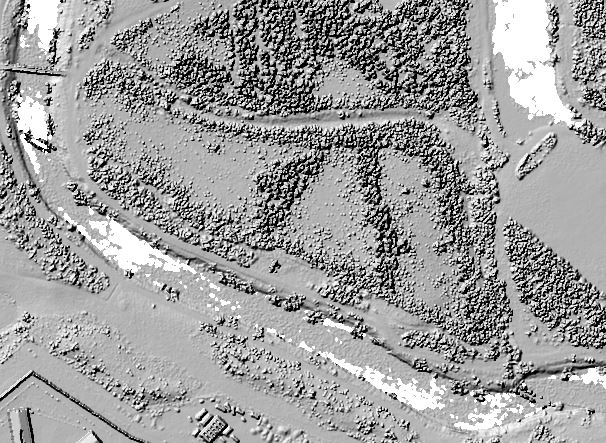
Lidar image of Prestwich mill area
|
A watermill at Kersal was also in operation and the location of this is well known, just above what was the Cussons site on the junction of Moor lane and Kersal Vale Rd, the area is now residential housing. The map of 1842 shows the Corn Mill, and also the Old, single track Agecroft Bridge
|

Map of 1842 showing the Kersal Corn Mill
|
|
Singleton Brook tumbled down from the northern edge of Kersal Moor, onto the flood plain of the Irwell alongside Moor Lane, and conveniently, where the brook passed alongside Moor Lane it was actually called “Mill Brook”.
|
The Brook was dammed as it fell down from Kersal Moor in order to provide a millpond above an overshot waterwheel and mill. The pond, as well as providing some height for a superior overshot wheel, would also give some continuity to the supply of water during dry spells.
The 1842 map also shows how the border between Kersal and Prestwich was altered to follow the western bank of the millpond. Placing the pond in Kersal and the mill in Prestwich. As was the case with Heaton Mill, which township the property stood in and who owned the land are two different things, and similarly to Heaton Mill, the land ownership is messy.
The earliest reference to a Mill at Kersal was in 1543 when a settlement was made by Baldwin Willoughby and Joan his wife regarding the manor and cell called Kersal, with twenty messuages (dwellings with land) , a water-mill, 1,000 acres of land, and 20s. rent.
Some eight years afterwards (1551) Kersal was sold to Ralph Kenyon, but as soon as Kenyon had purchased Kersal, he transferred one-third to Richard Siddall of Withington and another third to James Chetham of Crumpsall (1548).This also meant the mill had three owners too.
Chetham of CrumpsallHenry Chetham (1543-1603) had married (Jane)Ellen Wroe (1550-1616) of Heaton Gate, in Prestwich. Henry Cheetham senior was a successful merchant. had previously leased Crumpsall tenement from the Prestwich family of Hulme Hall, and had built Crumpsall Hall.
The Siddall ThirdThis third of Kersal, contained a third part of Kersal Manor and wood, with various lands and houses, passed through the Siddall family until it was alienated in 1616 to William Lever of Darcy Lever, who had married a daughter of George Kenyon of Kersal. It passed down the Lever family until in 1689 it was purchased by Henry son of Thomas Greenhalgh of Brandlesholme, and later sold to Samuel Clowes in 1775: ''one undivided third part of the manor or lordship of Kersal, and the whole of the capital messuage called Kersal Hall, with the appurtenances belonging, with third parts of the moor and mill'. Samuel Clowes at the same time conveyed a moiety of an undivided third part of the manor to Elizabeth widow of John Byrom, M.A.
By 1565 the Mill in Prestwich ran nearly 24/7.
'the said Jury doth agree the mylne shall from Sunday after the evening prayer tyll Saturday at ten of the clocke in the morning shall grind at all hours at both day and nyght providing there be water and worke’. (Prestwich Manor Court Book )
'Barlie’ was the grain most mentioned. All the tenants of the Lord of the Manor (Prestwich) had to grind their corn at his mill. They could take it away if it hadn't been dealt with within 24 hours. The miller was to be paid a shilling by his barlie measure according to the quantity.
|
As mentioned above, Singleton Brook was the border between Prestwich and Kersal, and when the millpond was added the border was redesigned ; the mill building itself was in Prestwich but the mill pond was in Kersal. The two manors shared ownership of the mill and its water supply jointly. This is clearly shown on the 1840s OS map when the old mill still existed. The Township boundary between Prestwich and Kersal unnaturally follows the north bank of the millpond, shifted from the course of the brook. There is a building on the South side of the millpond, which could also have been an old water mill building.
|
|
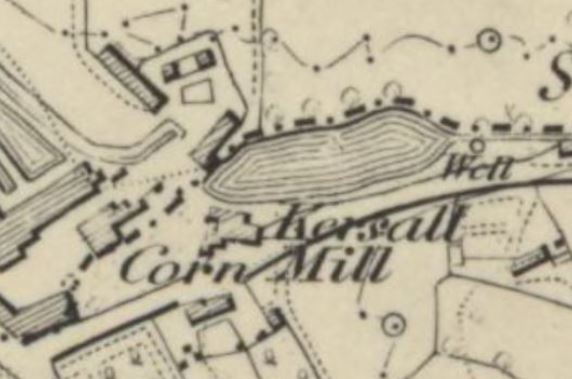
Map of 1842 showing the border
|
George Kenyon ChargedIn 1582 George Kenyon and Robert Ravald were charged by Ralph Byrom and Adam Pilkington with depriving the queen's tenants of Salford of their common pasture in Kersal Wood, stated to be 100 acres.
In 1613 the mill was rebuilt by Richard Holland of Denton and Heaton ( second husband of Margaret Langley acting as Lord of Prestwich in her name) and James Chetham (Lord of Kersal). It carried on under joint ownership with the Kersal side owning one third of the venture.
An Inventory exists for the miller, Peter Worsley, in 1670. As well as milling he kept a few pigs and hens and had a loom house with a pair of looms. He also had two fields of wheat and one of oats. The mill isn't specifically mentioned but 'in the chamber’ he had sacks of barley, empty sacks and a quantity of wool as well as other work gear. So this 'chamber' seems to be the mill chamber rather than a bedroom.
Peter Worsley was very definitely living in the Parish of Prestwich which confirms that Kersal Mill itself was in Prestwich, albeit exactly on the border with its water supply in Kersal.
In 1699 the mill was leased to Edward Byrom of nearby Kersal Cell for 99 years. In 1775 Samuel Clowes of Broughton Hall, who was assembling a property portfolio in north Salford, acquired the Byrom and Siddal thirds of Kersal's rights in the mill, along with Kersal Hall, and obtained the Chetham third by marriage to the Chetham heiress.
The start of the19th century saw the expansion of the mill site, with the conversion of a farm on the Prestwich side of the brook in 1818. This reflected the change in local trade from agricultural to cotton based industry. The factory was called the London Vale Works, where calico printing and dyeing were conducted. A number of lodges to hold the water required for the new works were constructed.
|
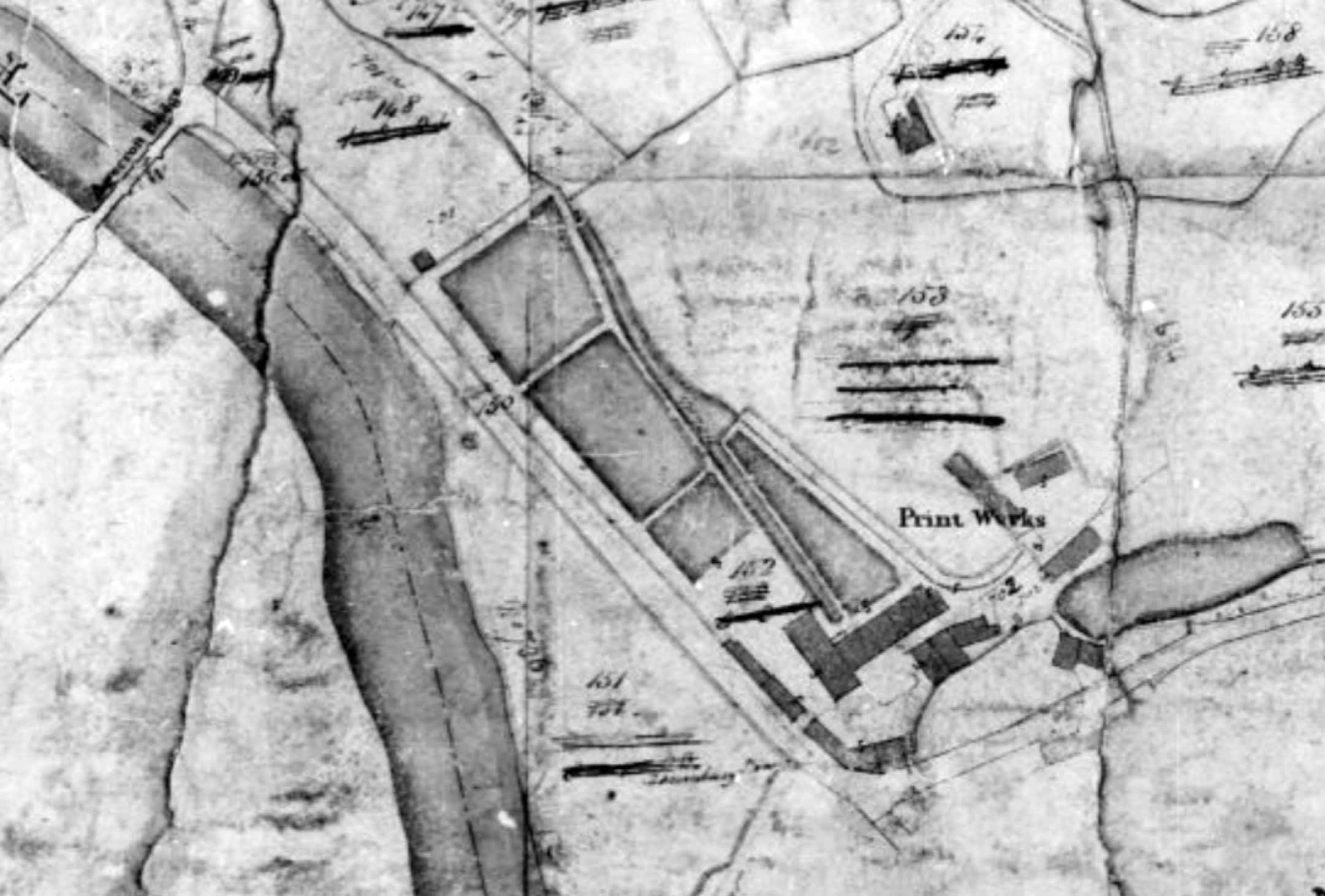
1839 Tithe Map
|
|
By 1824 the London Vale Works was operated by James & William Bayley calico-printers. They continued in ownership until around 1838 when the partnership between father and sons was dissolved.
[ A William Bayley of Hooley Hill, who along with his brother Charles, operated Bridge Street Mill in Stalybridge, was to be the trigger of what was to happen at Kersal Moor and London Vale Works in 1842.]
The works were then operated by Thomas Coston and James Lycett with the 1841 census showing Thomas Coston (aged 29) with his sons William and John living at London Vale, and James Lycette (aged 36) living nearby at Rainsough. Thomas Coston had been born in Shropshire, to Francis and Ann.
Read more about the Riots of 1842
|
The following year the London Vale works were advertised for let again:
PRINT WORKS—TO BE LET, ready for immediate working, all those Excellent and Compact Works called London Vale Print works. Situate near Agecroft Bridge, in the parish of Prestwich. The supply of water is unfailing, and coals abound in the immediate neighbourhood. The machinery is in capital working order, and in first-rate condition, a large portion of it having been recently put in; it must be taken with the copper rollers at a valuation. A more desirable opportunity for commencing printing without trouble, or works better adapted for the purpose is rarely to be met with. The premises will be let for the remainder of a lease of fourteen years, which eleven years and half are unexpired.'
[There was also a London Place print works on the West bank of the Irwell opposite Kersal Cell]
In 1850 Mr Edmund Coston, elder brother of Thomas, was appointed co-executor of the estate of Lewis Novelli, alongside Lewis's brother Alexander. The Novelli tomb and the story of Alexander's murder of his brother's wife is one of the more notorious stops on a tour of St Mary's Churchyard.
Edmund ultimately took ward of the orphaned Novelli child, Louisa, the family living at Ivy Cottage Higher Broughton, on Bury New Road.
|
|
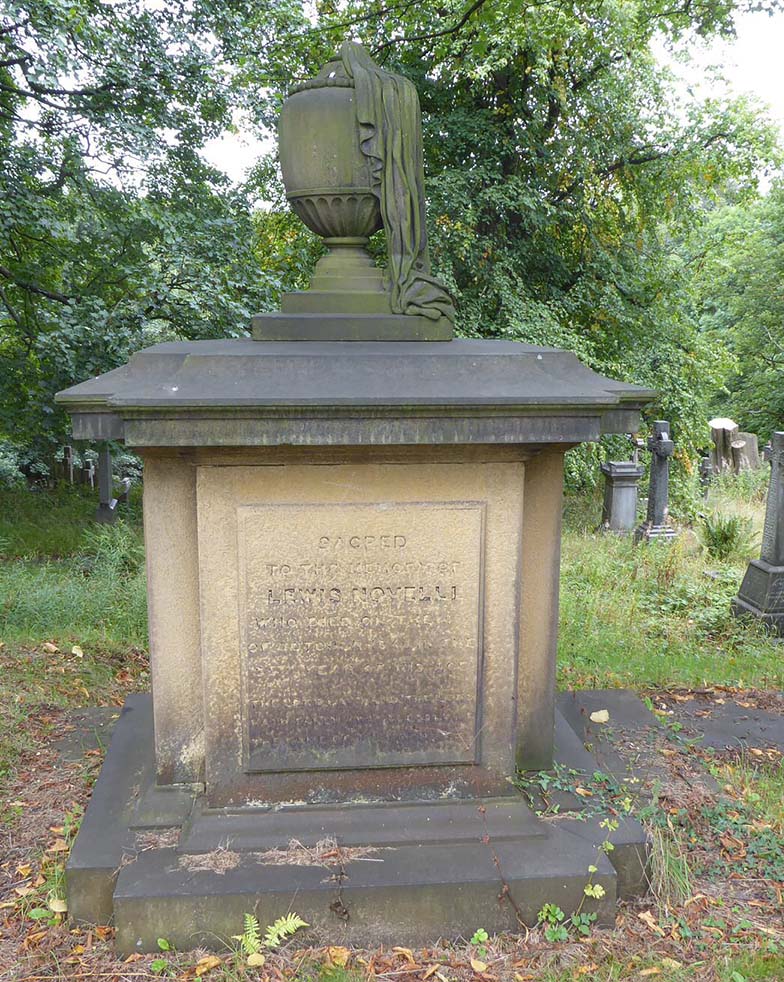
The tomb of Lewis & Harriet
|
Thomas lived at Rainsough House, which stood above Halliwell House (on the top edge of the 1891 map below).
Later Thomas went into partnership with Joseph Jackson promoting themselves as ‘printers of calicoes, muslins and other goods’ at Agecroft, but by 1851 Joseph Jackson had taken over sole operation. In that year the works were again advertised for let and by 1854 the business had failed owing £22,000 with assets of £20,000.
Despite the failure, the works were still in operation the following year, but perhaps a lack of investment and maintenance then lead to the death of an employee.
Reuben Pearson of Prestwich, a labourer at the print works, had gone to get water from a hot cistern. The tap had broken off the cistern, so Reuben stood on some wood to reach down and scoop the water up. He lost his footing on the wood and fell into the hot water. His workmates helped him back out but he died of the scolds to his body. The coroner heard that the tap had broken off the cistern several times, and that it could be easily protected in a box. The verdict of "accidental death" was given.
|
In 1863, Thomas Coston died aged 57, and was buried in the churchyard of St Mary's in Prestwich, not far from the Novelli tomb.
|
|
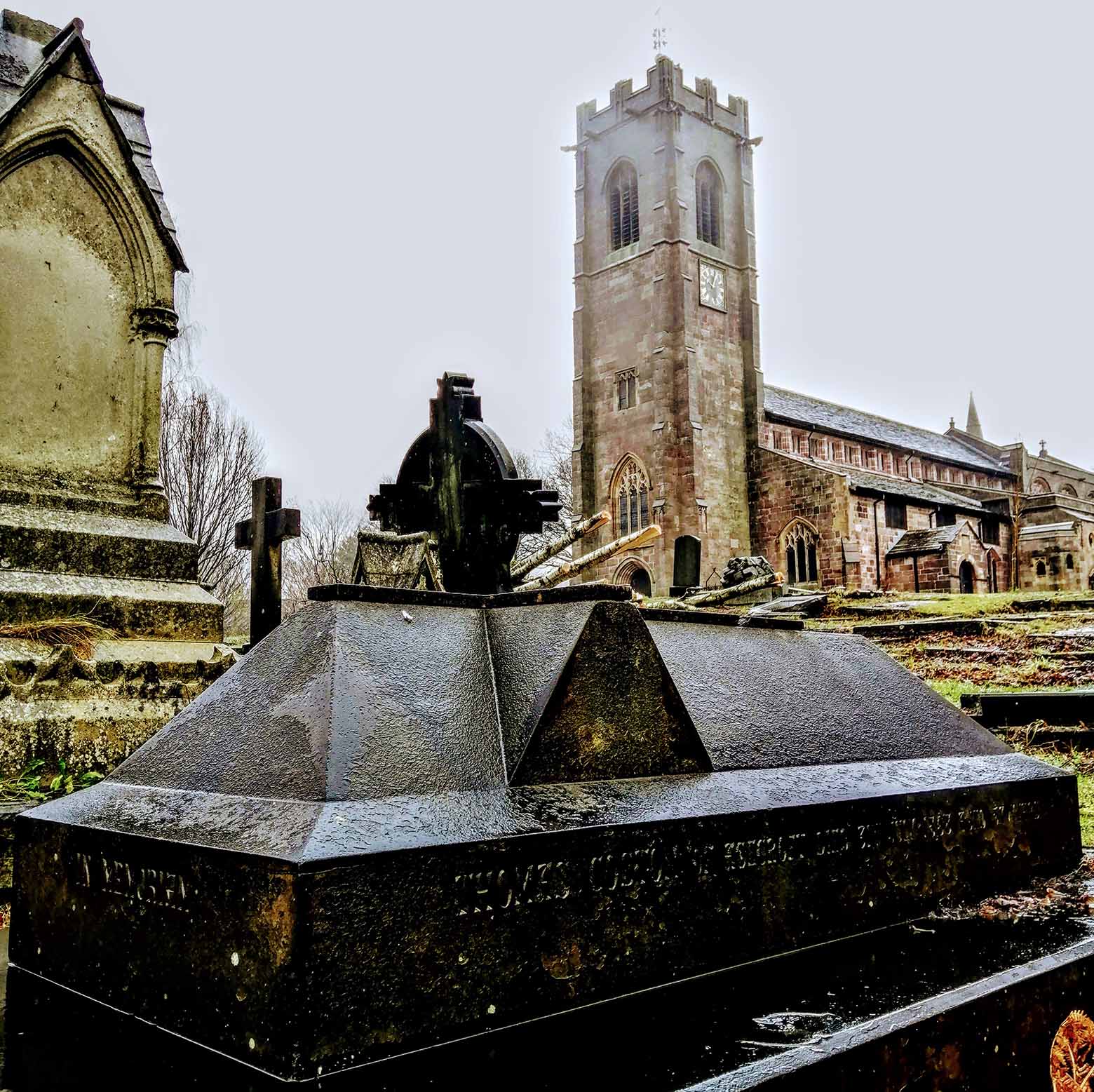
The tomb of Thomas Coston of Agecroft
|
John and Cable Brennand took over the works, and in 1868 a fire started in the "madder room". Madder was a plant source of red dyes which we know were being researched by Dr Edward Schunck with a house & laboratory on Vine Street, not far from the Dye Works.(see below).
The fire quickly spread and within 45 minutes the roof had collapsed. By 10pm, three hours later the walls collapsed and the building was totally destroyed. The fire put 200 employees out of work and damage was estimated between £8,000 to £10,000 which was only partially insured. The Brennands were declared bankrupt.
Despite the damage, Abraham Heywood, Nicholas Haworth and Joseph Beck had a partnership running Kersal Vale and Oakenshaw as Calico Printers, but the partnership split, with Haworth taking sole ownership on Kersal Vale in 1872.
Nicholas died in 1881 and is buried in St Paul's churchyard, Kersal Moor.
|

1891 Map
|
|
By 1891 the millpond had been drained, but the old mill building just north of the brook remained. Bayley and Craven were recorded at the print works that same year.
The site was disused for a period, although in 1905 Alfred Heywood(37) of Printworks Cottage, Kersal Vale, was buried at St Mary's Church in Prestwich. |
Alexander Tom Cussons was born in Leeds in 1875. His father Thomas had established a chemist's shop in 1869 in Leeds, and opened his 4th shop on Station Rd in Swinton in 1891. The focus of the business was medicine, but in 1897 Thomas bought a glass blowing factory in Harpurhey. Alexander was living on Worsley Road Swinton in 1901 and set up a partnership with Ernest Lake in the firm of Lake, Cussons, and Company, dissolved 1894.
Thomas died in 1905, and Cussons & Sons, under Alex had begun to specialize in detergents, and acquired the remains of London Vale Works in 1909. By 1911 Alexander Cussons lived in Halliwell House, the map of 1891 shows Holywell House on the hillside above the Works, and the location is now under Halliwell Rd. The company entered the production of soap in 1920.
"Cussons fortunes were assured in the 1930s, when the company bought up perfumers Bayley's of Bond Street. That purchase brought Cussons among other things, a popular fragrance known as Imperial Russian Leather."
"Cussons new soap featured novel packaging, as well as other features, such as a badge that remained visible to the end of the bar's use. These features helped Imperial Leather become England's bestselling bar soap brand, a position held into the next century."
|
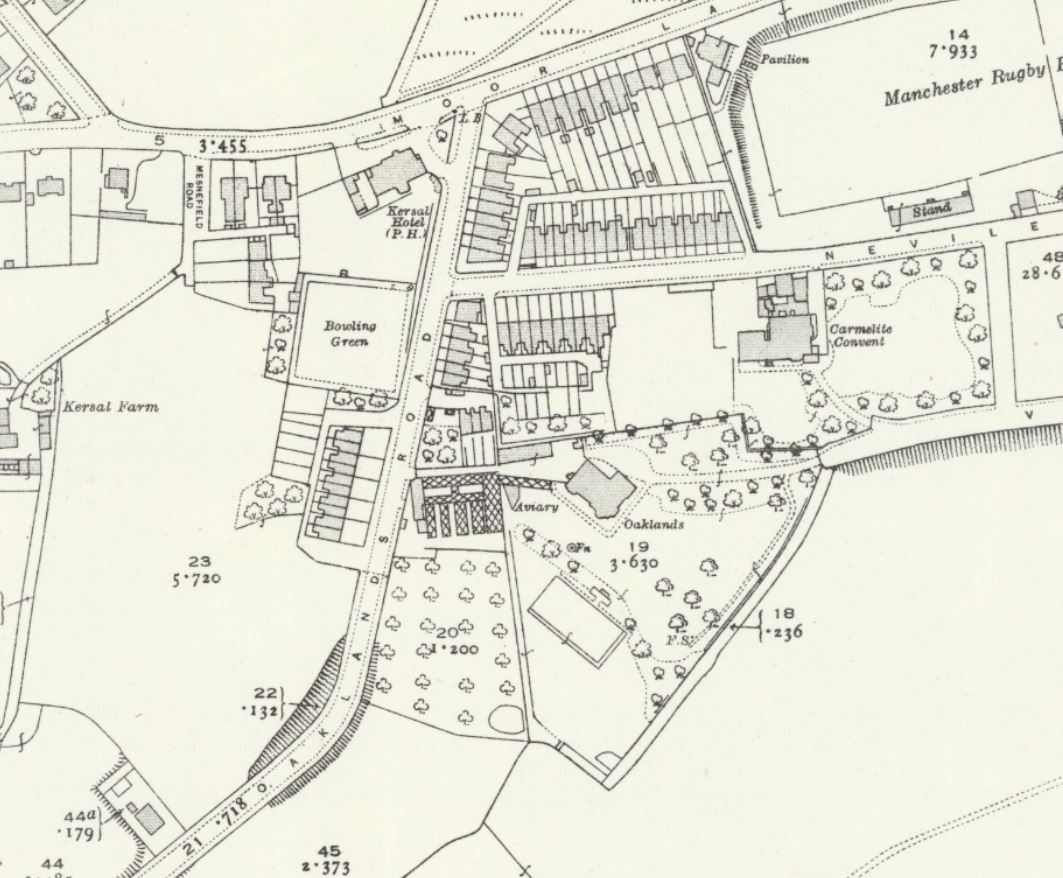
Oaklands 1932
|
|
Alex Cussons later moved to The Oaklands on Vine Street, just off Bury New Rd in Kersal, which had previously been owned by (Henry) Edward Schunck,PhD FRS, a British chemist of great renown.
|
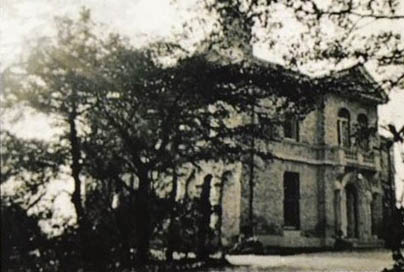
Oaklands, Vine St
Alex Cusson purchased Oaklands after Edward Schunck's death, housing his collection of rare orchids in the glass-houses there. Unfortunately the house was badly damaged and many of the orchids destroyed when a bomb landed at the bottom of the garden during the Blitz of 1941. In 1951 Alex died and is buried at St Paul's churchyard, Kersal Moor.
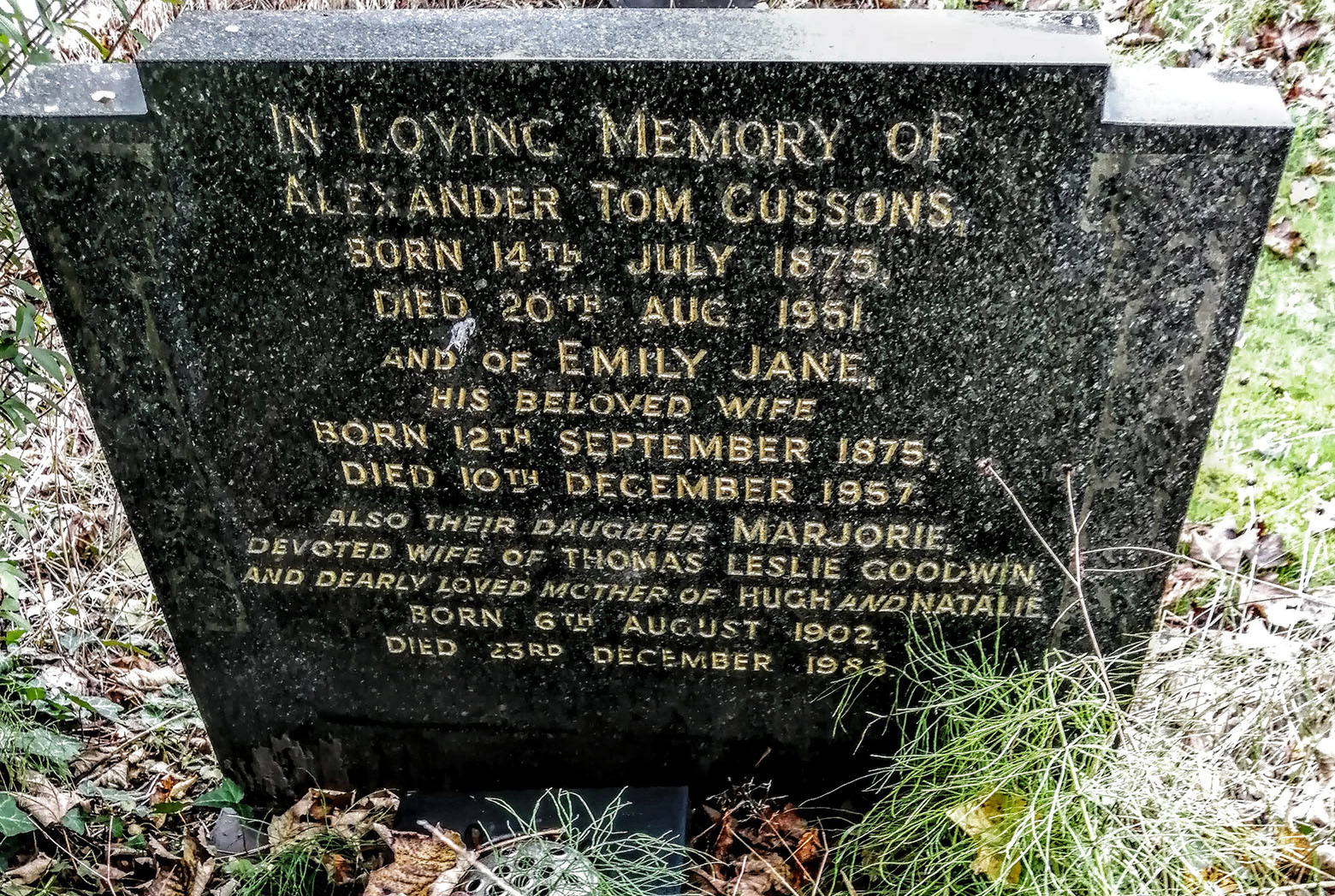
Alex Cussons Headstone
Cussons became PZCussons and manufacturing moved to Europe, however the company stayed local creating an innovation center just over the Irwell in Salford. With the demolition of the factory, the site has now been used for a housing development.
Recognising the large amount of Industrial Archaeology present on the brownfield site, despite the expansion that had occurred during the Cussons era, an excavation was performed focusing on the older areas of the site near where the millpond and Corn Mill were located.
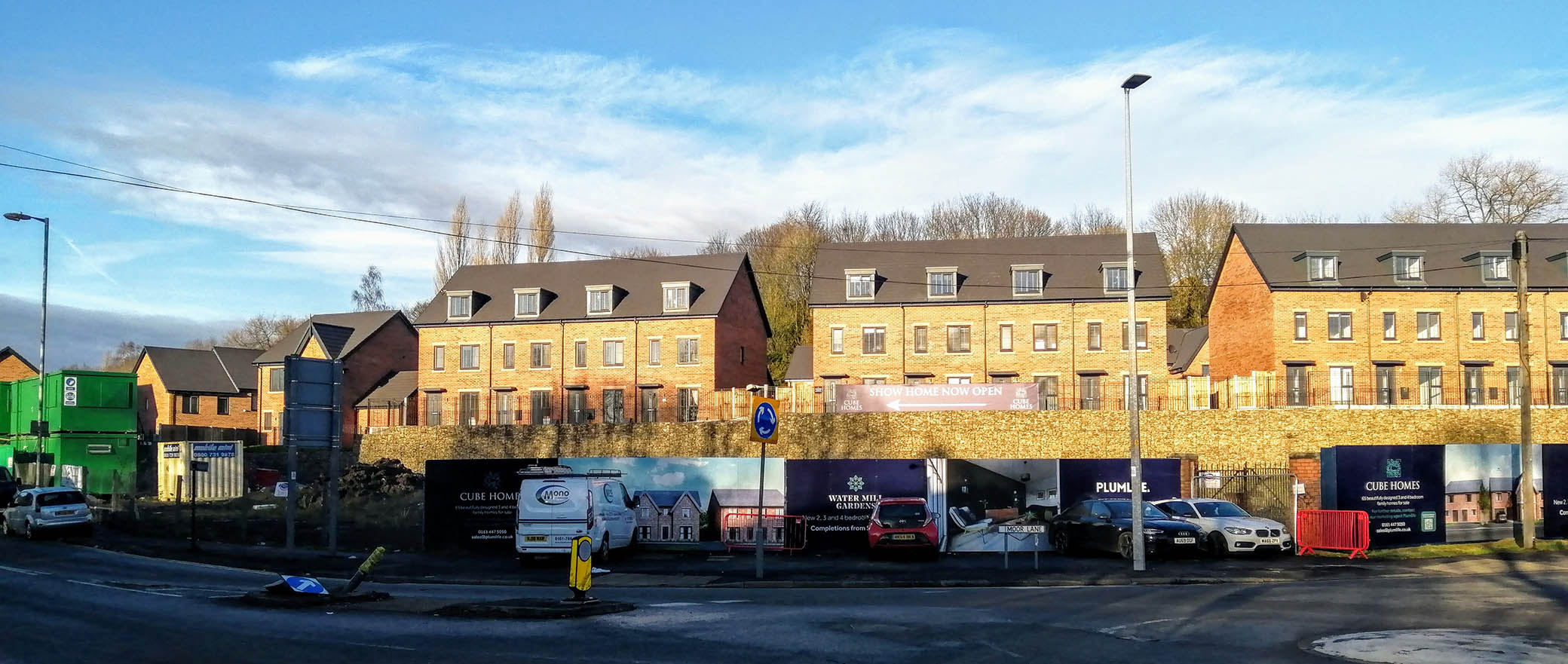
New housing
See this website for more photos of Cussons Soap Works.
 Lords
Worship
People
Places
People
Contact
Lords
Worship
People
Places
People
Contact